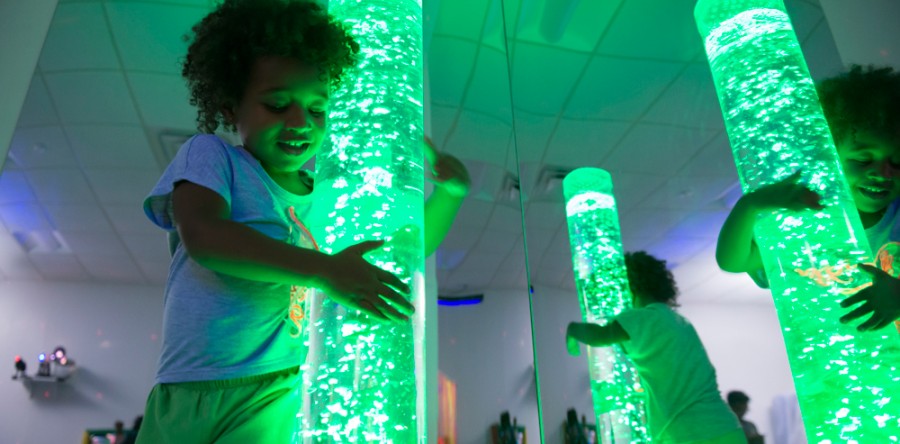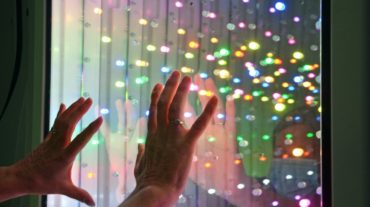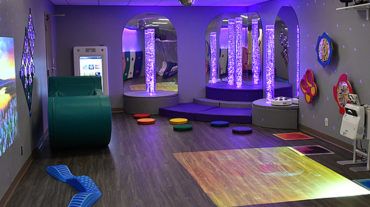Stockton Elementary School enrolls approximately 500 students, and is Chicago’s northernmost receiving school for early childhood students with special needs. With both an early childhood special education program for ages 3 to 6 and special education classes for students’ ages 7 to 12, Stockton caters to about 100 students with a range of special needs, including autism, Down’s syndrome, developmental and cognitive delay, emotional and behavioral problems, and hearing impairment.
Sandler, a speech therapist at Stockton since 1989, describes the school as a friendly place with a great student population and supportive parents, but just a few years ago she became convinced that the school could become an even better place for both students and teachers by creating its own Snoezelen® room and exposing children to regular Snoezelen sessions.
A Snoezelen consultant at FlagHouse, Inc., the exclusive U.S. distributor of Snoezelen equipment, says that she originally quoted Sandler a typical figure of $40,000 for a complete Snoezelen room, but Sandler was prepared to go much further in her fundraising efforts. In fact, she says she told the FlagHouse representative
“I want the best Snoezelen room in the country. I’m not kidding.”
The room’s design came together through the combined efforts of Sandler, Carolyn Jackson, a Snoezelen consultant from FlagHouse, Inc., and Linda Messbauer, MA, OTR/L, a New York-based occupational therapist with extensive Snoezelen experience, allowing for optimal attention to both aesthetics and functionality. Sandler’s impressive attention to detail and ample budget resulted in a room that is not only pleasing to the senses, but also full of practical customizations such as individual electrical switches for each piece of equipment, dimmers for all the lights, and the ability to operate all equipment by remote control.
According to Sandler, the results they are seeing have exceeded even her highest expectations: passive students begin to take an active role in exploring their environment, hyperactive children are able to relax and calm down, students are able to learn about cause and effect, and some students who were previously nonverbal have actually begun to speak in the Snoezelen room.
One little girl, whom Sandler describes as a “selective mute,” refused to speak at school; the staff at Stockton had never heard her say a word. One day during a Snoezelen session, she suddenly grabbed the microphone attached to a piece of equipment that measures and visually reflects sound production, and began to sing! Sandler explains that students “feel so free in there that they use more language.” While in the Snoezelen room, these children are happy, secure, calm, and engaged with their environment.
The positive results are not limited to the time that the students spend in Stockton’s Snoezelen room either. According to Sandler, approximately 1 year after introducing Snoezelen into the school, she and the other teachers are beginning to see a carryover in the behavior of their students with special needs after sessions in the room. One of the results Sandler had hoped to see when she first decided to develop a Snoezelen room was an improvement in students’ attention spans
Now that students have been exposed and become accustomed to this multisensory environment, their attention spans have improved. In addition, she says the children have learned the routine surrounding their Snoezelen sessions, so they know to take their shoes off before they enter the room, and they are aware that the dimming or brightening of the lights in the room indicates the beginning or end of the session.
For many students with special needs, simply learning and appropriately responding to this routine is a big deal. Perhaps an even more impressive indicator of the impact Snoezelen is having on the students at Stockton is that the children have begun to ask for sessions in their special room. Many nonverbal students, including some of those with autism, use a picture exchange communication system (PECS), in which a picture can be used in place of speech. Classrooms for students with special needs at Stockton are equipped with Snoezelen pictures, which kids will show to their teachers in order to request time in the Snoezelen room.
In the Snoezelen room, “the kids are happy,” says Sandler. And when the students are happy, calm, secure, and relaxed, learning can take place.





